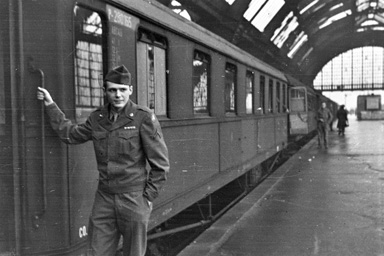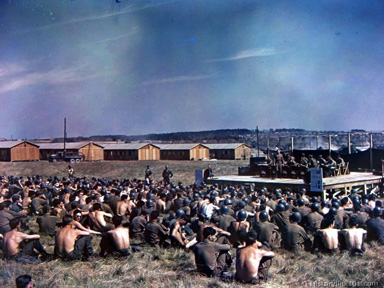WWII trials shaped Waterloo architect's 'upbeat' outlook
Posted
by Pat Kinney
on Wednesday, March 24, 2021
WATERLOO -- The jovial man who leads the Waterloo Rotary Club meetings in song every Monday has every reason to sing.
.JPG)
Hovey Brom is shown here in the downtown Waterloo offices of InVision Architecture, the successor of the Waterloo architectural firm he was a partner in for decades
Today feels like heaven compared to 77 years ago.
That man, longtime Waterloo architect Hovey Brom, 95, spent a good part of World War II crawling on his hands and knees probing for German land mines with a bayonet and marking them, making the way safer for his comrades' advance.
He also was a forward observer for the 16th Armored division of Gen. George S. Patton's U.S. Third Army, scouting enemy lines in a Jeep mounted with a machine gun. In that job he had two windshields shot out by snipers and another round barely miss his head. On another occasion, a sniper shot punctured his radiator, disabling his Jeep. He commandeered a bicycle to continue and complete his scouting mission.
And Brom did a lot more than "sing for his supper" when he arrived in Waterloo after graduating from Iowa State University in 1952 on the G.I. bill. As a partner at Thorson Brom Broshar Snyder Architects, now InVision Architecture, the Des Moines Roosevelt High School graduate with his partners designed many of the landmark buildings in Waterloo and on the University of Norther Iowa campus. They include, among others, the UNI-Dome, the Waterloo Center for the Arts, the Grout Museum and its multiple additions, the Five Sullivan Brothers Convention Center, many hospital additions and, also at UNI, Russell Hall, McCollum Science Hall, Rod Library and two renovations of Seerley Hall. He also designed numerous churches throughout Waterloo-Cedar Falls. He has received several community and professional awards.

Hovey Brom, shown here during World War II, served in the 16th Armored Division of Gen. George S. Patton Jr.'s U.S. Third Army
The war, plus growing up in the Depression in Des Moines and overcoming a debilitating auto accident on a hay rack ride in high school - in which his girlfriend was killed when the hay rack was hit by a truck - all shaped his outlook and drive later in life.
"It taught me to appreciate the stability of our country," he said. "I grew up during the Depression; we lived in four different houses because we couldn’t pay the rent and often with no electricity, they sent me to live with my grandparents on the farm," near Fort Dodge, where he worked summers.
"During the war our situation became a little more stable but then the Army experience showed me even worse unstable conditions which were unbelievable," he said. During an oral history interview with Grout Museum, he was overcome with emotion as he recalled discovering a group of emaciated Polish prisoners of war in an abandoned German stockade on one of his reconnaissance missions. He also recalled months in the field, sleeping outside with little if any hot food and on continuous edge in seemingly endless duty.
"When I got home my Iowa world was like heaven, stable, satisfying, predictable. The war really taught me how valuable this was to me and those around me," he said. "Also I found a wife, a family and many friends. Can’t beat that!"
Brom was drafted in 1944. After basic training stateside, his troop ship survived couple of German U-boat attacks on the voyage across the Atlantic. He arrived in Le Havre, France in early 1945 at the conclusion of the Battle of the Bulge, in time for the Allies' and Patton's army's final thrust into Nazi-occupied Europe and the end of the war.
His division met up with Soviet troops in Czechoslovakia near Prague. He was put into service as a Jeep driver for a Soviet general for a time, as that general scouted out what would eventually be a line of demarcation dividing Eastern and Western Europe that would eventually be referred to by British prime minister Winston Churchill as the Iron Curtain. Brom recalled seeing streams of Czech refugees and defeated German troops flooding west to Western Allied forces rather than live or be imprisoned under Soviet rule -- the earliest traces of what would become the Cold War. Not all of them made it.
Brom received a new duty at war's end which was an uplifting reprieve from the devastation he had witnessed. He had an opportunity to audition for a U.S. military band in Munich, Germany. He'd played trombone in high school but flunked the initial military band audition. Then he discovered they needed a string bass player -- which he had played just twice in high school. Lacking any competition he made the cut and became part of the 115th AGF (Army Ground Forces) band, which entertaind troops waiting to be shipped home after the war.

Hovey Brom was a string bass player in the 115 A.G.F. Band, a swing band shown here entertaining members of the U.S. 87th. "Golden Acorn" Infantry Division at the Oklahoma City Redeployment Camp in France in June 1945. Brom played string bass and he and his instrument are barely visible behind the conductor.
At the time of his audition, Brom originally thought it was a military band which would be playing martial music, but found out it was a swing band and bandmates include some of the finest big-band musicians in the United States, having played with the Tommy Dorsey Orchestra and other ensembles. He became a bit overcome with emotion when he recalled the quality of the musicians with which he played. He said he wasn't quite up to their abilities but eventually stepped up his game to be able to perform with them.
In recalling his stint with the band, Brom said, "I was reminded of my learning the thrill you get when you end a band concert and the audience claps and yells because you have given them a couple of hours of pleasure. When you bow back to them, a thrill goes through you from your toes to the top of your head that is hard to describe."
In recalling those days during his oral history for the Grout, Brom said, "I got that feeling again that someone would care enough to listen to me remember this past."
The Grout Museum District and the Sullivan Brothers Iowa Veterans Museum have recorded some 2,000 oral histories like Brom's of Iowa military veterans from all eras and branches of service for posterity for historic exhibits and research. We also are compiling a registry of Iowa veterans. If you are or know a veteran with a story to tell, please contact the Grout Museum at (319) 234-6357, 503 South St. Waterloo, Iowa, 50701, visit our website at groutmuseumdistrict.org/voices-of-iowa/ or email us at info@gmdistrict.org.